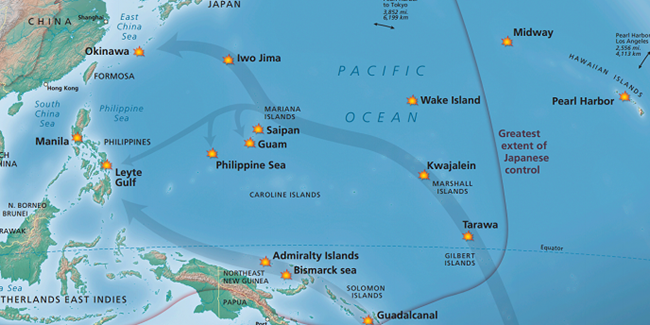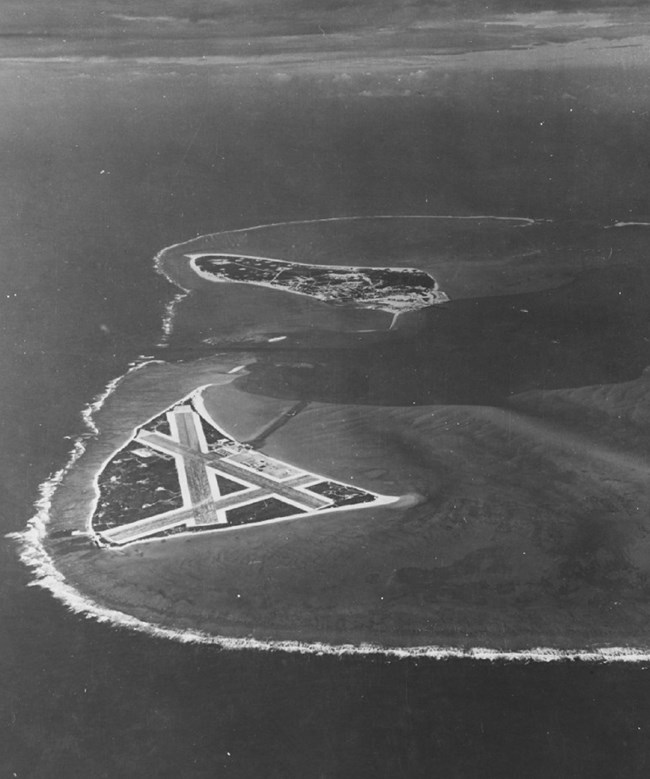
Emerging PowersThe traditionally inward-looking but rapidly industrializing United States began to move onto the world stage in the 1890s. By the end of the century, it was a colonial power, having annexed Hawaii, the Philippines, Guam, and Puerto Rico. The nation warmed to its new role, shedding its neutrality in World War I by declaring war on Germany in 1917. The next year it sent a force of 1.75 million soldiers to aid the Allies. O'ahu was caught up in global geopolitics as the expanding Pearl Harbor Naval Station on the island became the emblem of a fledgling U.S. empire with growing interests in the Pacific.Japan was also making its presence known in the Pacific. Since the 1860s, it had been swiftly modernizing, transforming itself through industrialization and militarization from a dynastic feudal society to a regional power. By 1910, Japan had defeated China and Russia in armed conflicts, annexed Korea and Formosa, and occupied Manchuria. An ally of Britain, it took control of Germany's Pacific islands during World War I. Lacking natural resources to sustain its industry, Japan resolved to establish control over what it called the Southern Resource Area - Southeast Asian countries rich in oil, tin, iron, and rubber - putting it on a collision course with European colonial powers. During the 1930s, Japan grew more nationalistic and militaristic. In 1940, it established the Greater East Asia Co-Prosperity Sphere, a bloc of Asian nations freed of western influence, to gain access to their resources. It joined the Axis powers through the Tri-Partite Pact with Germany and Italy. In response, the United States moved the Pacific Fleet to Pearl Harbor in 1941 and embargoed oil bound for Japan. Knowing the U.S. Navy was repositioning, Japan decided to strike early and secure new territories before the United States and its allies could respond. 
The Asia-Pacific WarThe U.S. Pacific Fleet was knocked back on its heels by the Pearl Harbor attack, while coordinated Japanese attacks overran Southeast Asia and the southern Pacific. But the U.S. Navy quickly regrouped, and six months later would deliver an effective counterpunch. As the Pacific War heated up, Pearl Harbor became the center for U.S. operations in the Pacific, commanded by Adm. Chester Nimitz. Gen. Douglas MacArthur, headquartered in Australia, commanded U.S., British, Australian, and New Zealand forces in the southwest Pacific area. After Pearl Harbor, Germany declared war on the U.S., and America faced a two-ocean war. With the U.S. fleet divided, the Japanese had a decided advantage in Pacific warship numbers. U.S. industrial strength, however, allowed the military to rapidly expand its arsenal of ships, aircraft, and tanks, while Japan could not quickly enough replace its military hardware or skilled pilots lost in combat.The damage to the U.S. Pacific Fleet battle line at Pearl Harbor hastened the end of the battleship era. The primary warship became the aircraft carrier, whose warplanes could support or thwart the amphibious landings so crucial in the Pacific theater. On this immense battlefield, carriers fought out of sight of each other, as the "flat-tops" launched swarms of dive-bombers and torpedo planes to seek out the opposing fleet. Battleships remained tactically valuable, defending carriers and shelling islands before amphibious landings, but strategically this was a carrier war. Knowing Japan's only chance was to reduce U.S. carrier power, Adm. Isoroku Yamamoto planned to lure the U.S. fleet into battle off Midway in June 1942. U.S. intelligence broke the Japanese naval code, allowing the U.S. Navy to set a trap and ambush the Japanese carriers. Japan lost four of its six carriers at Midway and was forced onto the defensive. Allied offensive strategy then took three broad paths: the push across the central Pacific toward the Japanese homeland with a bloody "island-hopping" campaign by the U.S. Navy, Marine and Army forces; the Allied drive in the southwest Pacific toward the Philippines; and the engagement with our allies in the China, Burma, and India theater. By 1944, the Japanese Navy was wearing down. U.S. submarines decimated Japan's shipping, especially oil tankers bearing the lifeblood of its war machine. It was only a matter of time before Japan surrendered or the Allies invaded its home islands. After U.S. atomic bombs devastated Hiroshima and Nagasaki, Japan accepted terms of surrender. On September 2, 1945, aboard the USS Missouri in Tokyo Bay, the brutal Pacific War came to an end. Important Sites of the Pacific War:
|
Last updated: September 28, 2025
